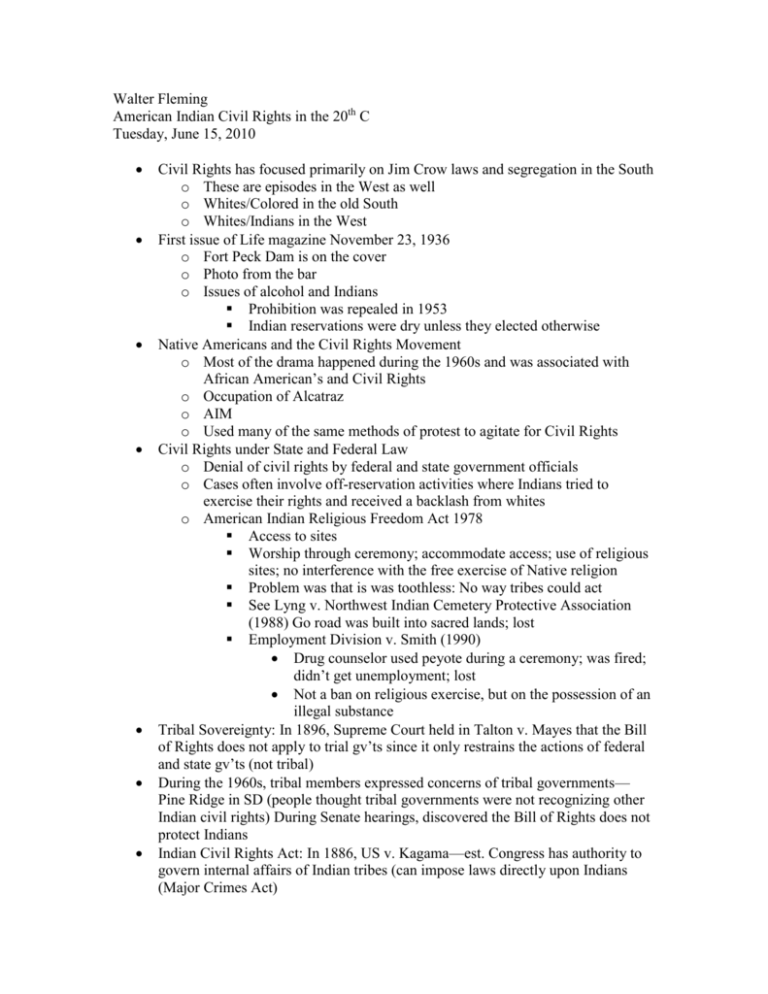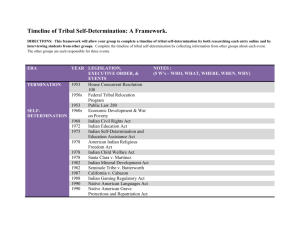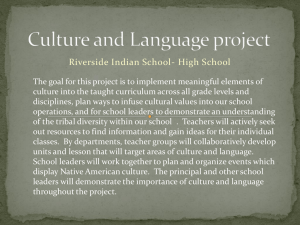Walter Fleming American Indian Civil Rights in the 20th C Tuesday
advertisement

Walter Fleming American Indian Civil Rights in the 20th C Tuesday, June 15, 2010 Civil Rights has focused primarily on Jim Crow laws and segregation in the South o These are episodes in the West as well o Whites/Colored in the old South o Whites/Indians in the West First issue of Life magazine November 23, 1936 o Fort Peck Dam is on the cover o Photo from the bar o Issues of alcohol and Indians Prohibition was repealed in 1953 Indian reservations were dry unless they elected otherwise Native Americans and the Civil Rights Movement o Most of the drama happened during the 1960s and was associated with African American’s and Civil Rights o Occupation of Alcatraz o AIM o Used many of the same methods of protest to agitate for Civil Rights Civil Rights under State and Federal Law o Denial of civil rights by federal and state government officials o Cases often involve off-reservation activities where Indians tried to exercise their rights and received a backlash from whites o American Indian Religious Freedom Act 1978 Access to sites Worship through ceremony; accommodate access; use of religious sites; no interference with the free exercise of Native religion Problem was that is was toothless: No way tribes could act See Lyng v. Northwest Indian Cemetery Protective Association (1988) Go road was built into sacred lands; lost Employment Division v. Smith (1990) Drug counselor used peyote during a ceremony; was fired; didn’t get unemployment; lost Not a ban on religious exercise, but on the possession of an illegal substance Tribal Sovereignty: In 1896, Supreme Court held in Talton v. Mayes that the Bill of Rights does not apply to trial gv’ts since it only restrains the actions of federal and state gv’ts (not tribal) During the 1960s, tribal members expressed concerns of tribal governments— Pine Ridge in SD (people thought tribal governments were not recognizing other Indian civil rights) During Senate hearings, discovered the Bill of Rights does not protect Indians Indian Civil Rights Act: In 1886, US v. Kagama—est. Congress has authority to govern internal affairs of Indian tribes (can impose laws directly upon Indians (Major Crimes Act) 1968: Congress enacted the Indian Civil Rights Act protecting rights of all persons against acts of tribal governments Section 1301. Definition—receive many of the rights in the Bill of Rights (except the right to bear arms) For some, it finally gives individuals certain rights and protection. For others, it has eroded tribal sovereignty by allowing Indian affairs to be governed by Congress Challenges to tribal governments—Santa Clara Pueblo v. Martinez: 1934 est. tribal governments. One thing that was est. was the ability to define membership o Woman marries a Navajo and had 7 children o Pueblo denies membership to the woman’s children accord. to tribal membership rules o Federal court upholds tribal ruling Citizenship o Citizenship Act passed in 1924, but being citizens meant they could not vote: Indians not taxed could not vote; Indians under guardianship could not vote (what about whites—no, all could vote) o Montana—in order to vote, you had to be a citizen AND a taxpayer (same on many reservations) o Montana Indian Voting Rights (Windy Boy v. Big Horn) 1980s o 14th and 15th Amendment to Constitution (Citizenship and right to vote) So why were Indians not allowed to vote? 1986 o See Big Horn county demographics o County is 55% white and 45% Indian; Hardin is 85% white and 15% Indian o Governing body is at-large (all could be from Hardin and represent all of Big Horn county or all could be from Lodge Grass and represent Big Horn county) o At-large elections are ruled as constitutional o Indians were not allowed to register or were dropped from the voting lists o Argument was a Racially Polarized Voting—people would vote for a candidate of the same race o In order to see if there was election discrimination, had to examine election Practices: whether state or county has unusually large districts (if you’re from Hardin, you only have to campaign in Hardin, but if you’re from Lodge Grass, you have to campaign in the whole county) o Single Shot voting—If there is polarized voting: Tell constituents to only cast one vote; in some elections, you have to vote for 2—if that happens, then the minority candidate will never win o Whether there are majority vote requirements (do you have to have 50% or more?) Not a case here o Whether there are staggered terms—means that during every election o Whether candidates must run for numbered posts (In Big Horn—because you can be at-large, then all candidates could be from Hardin) o Remedy to the Big Horn case: Created 3 districts (1 predominantly white, 1 predominantly native, and 1 mixed) o Impact: Blaine County, MT—has same type of demographics—in 1999, US sued the county for at-large elections Indian people are a political group, not an ethnic group or race; under each tribe, you have a mix of races and ethnic groups







